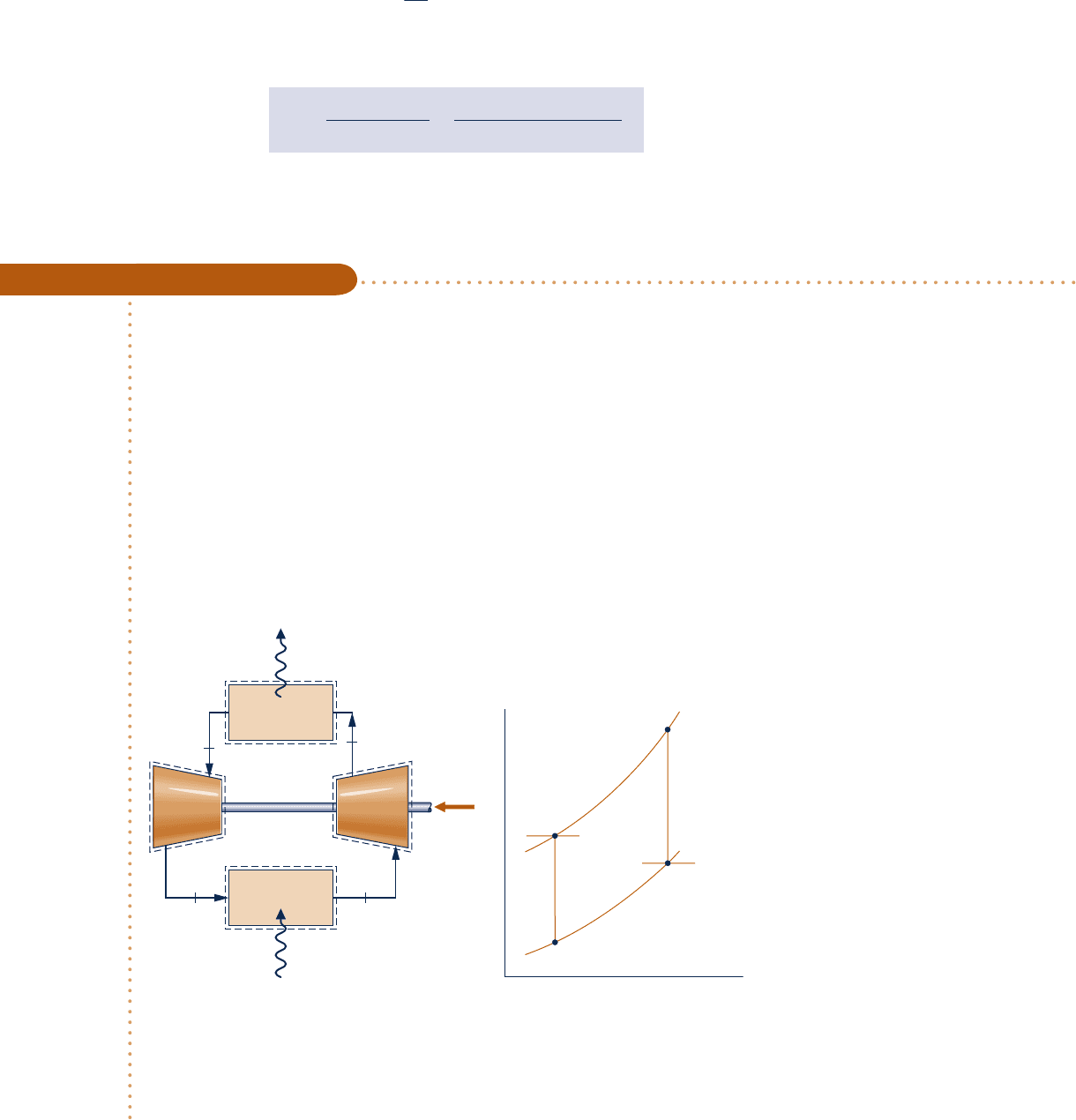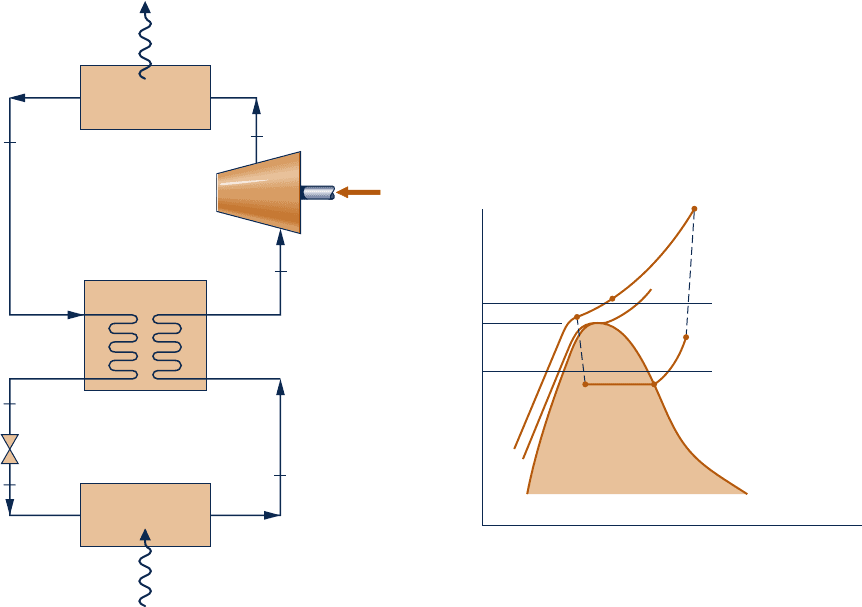Moran M.J., Shapiro H.N. Fundamentals of Engineering Thermodynamics
Подождите немного. Документ загружается.


In obtaining these expressions, heat transfer with the surroundings and changes in
kinetic and potential energy have been ignored. The magnitude of the work devel-
oped by the turbine of a Brayton refrigeration cycle is typically significant relative to
the compressor work input.
Heat transfer from the cold region to the refrigerant gas circulating through the
low-pressure heat exchanger, the refrigeration effect, is
Q
#
in
m
#
5 h
1
2 h
4
The coefficient of performance is the ratio of the refrigeration effect to the net
work input:
b 5
Q
#
in
/
m
#
W
#
c
/
m
#
2 W
#
t
/
m
#
5
1h
1
2 h
4
2
1h
2
2 h
1
22 1h
3
2 h
4
2
(10.11)
In the next example, we illustrate the analysis of an ideal Brayton refrigeration
cycle.
Analyzing an Ideal Brayton Refrigeration Cycle
c c c c EXAMPLE 10.5 c
Air enters the compressor of an ideal Brayton refrigeration cycle at 1 atm, 480°R, with a volumetric flow rate
of 50 ft
3
/s. If the compressor pressure ratio is 3 and the turbine inlet temperature is 540°R, determine (a) the
net power input, in Btu/min, (b) the refrigeration capacity, in Btu/min, (c) the coefficient of performance.
SOLUTION
Known:
An ideal Brayton refrigeration cycle operates with air. Compressor inlet conditions, the turbine inlet
temperature, and the compressor pressure ratio are given.
Find: Determine the net power input, in Btu/min, the refrigeration capacity, in Btu/min, and the coefficient of
performance.
Schematic and Given Data:
Engineering Model:
1.
Each component of the
cycle is analyzed as a con-
trol volume at steady state.
The control volumes are
indicated by dashed lines on
the accompanying sketch.
2. The turbine and compressor
processes are isentropic.
3. There are no pressure drops
through the heat exchangers.
4. Kinetic and potential energy
effects are negligible.
5. The working fluid is air
modeled as an ideal gas.
Fig. E10.5
T
3
=
540°R
T
1
=
480°R
2s
4s
p = 3 atm
p = 1 atm
s
T
3
1
4s 1
3
2s
Heat exchanger
Heat exchanger
Turbine Compressor
Q
out
·
Q
in
·
W
cycle
·
T
3
=
540°R
(AV)
1
=
T
1
=
p
1
=
50 ft
3
/s
480°R
1 atm
10.7 Gas Refrigeration Systems 613
c10RefrigerationandHeatPumpSyste613 Page 613 6/21/10 3:29:05 PM user-s146c10RefrigerationandHeatPumpSyste613 Page 613 6/21/10 3:29:05 PM user-s146 /Users/user-s146/Desktop/Merry_X-Mas/New/Users/user-s146/Desktop/Merry_X-Mas/New

614 Chapter 10 Refrigeration and Heat Pump Systems
Analysis: The analysis begins by determining the specific enthalpy at each numbered state of the cycle. At state
1, the temperature is 4808R. From Table A-22E, h
1
5 114.69 Btu/lb, p
r1
5 0.9182. Since the compressor process
is isentropic, h
2s
can be determined by first evaluating p
r
at state 2s. That is
p
r2
5
p
2
p
1
p
r1
5 13210.918225 2.755
Then, interpolating in Table A-22E, we get h
2s
5 157.1 Btu/lb.
The temperature at state 3 is given as T
3
5 5408R. From Table A-22E, h
3
5 129.06 Btu/lb, p
r3
5 1.3860. The
specific enthalpy at state 4s is found by using the isentropic relation
p
r4
5 p
r3
p
4
p
3
5 11.3860211
/
325 0.462
Interpolating in Table A-22E, we obtain h
4s
5 94.1 Btu/lb.
(a) The net power input is
W
#
cycle
5 m
#
31h
2s
2 h
1
22 1h
3
2 h
4s
24
This requires the mass flow rate m
#
, which can be determined from the volumetric flow rate and the specific
volume at the compressor inlet:
m
#
5
1AV2
1
y
1
Since y
1
5 1R
/
M2T
1
/
p
1
m
#
5
1AV2
1
p
1
1R
/
M2T
1
5
150 ft
3
/
s2
Z
60 s
/
min
Z
114.7 lbf
/
in.
2
2
Z
144 in.
2
/
ft
2
Z
a
1545 ft ? lbf
28.97 lb ? 8R
b14808R2
5 248 lb
/
min
Finally
W
#
cycle
5 1248 lb
/
min231157.1 2 114.6922 1129.06 2 94.124 Btu
/
lb
5
1848 Btu
/
min
(b) The refrigeration capacity is
Q
#
in
5 m
#
1h
1
2 h
4s
2
5 1248 lb
/
min21114.69 2 94.12 Btu
/
lb
5 5106 Btu
/
min
(c) The coefficient of performance is
➊ b 5
Q
#
in
W
#
cycle
5
5106
1848
5 2.76
➊ Irreversibilities within the compressor and turbine serve to decrease the
coefficient of performance significantly from that of the corresponding ideal
cycle because the compressor work requirement is increased and the turbine
work output is decreased. This is illustrated in Example 10.6.
Ability to…
❑
sketch the T–s diagram of the
ideal Brayton refrigeration
cycle.
❑
fix each of the principal states
and retrieve necessary
property data.
❑
calculate net power input,
refrigeration capacity, and
coefficient of performance.
✓
Skills Developed
Determine the refrigeration capacity in tons of refrigeration.
Ans. 25.53 ton.
c10RefrigerationandHeatPumpSyste614 Page 614 6/21/10 3:29:08 PM user-s146c10RefrigerationandHeatPumpSyste614 Page 614 6/21/10 3:29:08 PM user-s146 /Users/user-s146/Desktop/Merry_X-Mas/New/Users/user-s146/Desktop/Merry_X-Mas/New

Example 10.6 illustrates the effects of irreversible compression and turbine expan-
sion Building on Example 10.5, on the performance of Brayton cycle refrigeration.
For this, we apply the isentropic compressor and turbine efficiencies introduced in
Sec. 6.12.
Evaluating Performance of a Brayton Refrigeration Cycle with Irreversibilities
Reconsider Example 10.5, but include in the analysis that the compressor and turbine each have an isentropic
efficiency of 80%. Determine for the modified cycle (a) the net power input, in Btu/min, (b) the refrigeration
capacity, in Btu/min, (c) the coefficient of performance, and discuss its value.
SOLUTION
Known:
A Brayton refrigeration cycle operates with air. Compressor inlet conditions, the turbine inlet tempera-
ture, and the compressor pressure ratio are given. The compressor and turbine each have an isentropic efficiency
of 80%.
Find: Determine the net power input and the refrigeration capacity, each in Btu/min. Also, determine the coef-
ficient of performance and discuss its value.
Schematic and Given Data:
Analysis:
(a) The power input to the compressor is evaluated using the isentropic compressor efficiency, h
c
. That is
W
#
c
m
#
5
1W
#
c
/
m
#
2
s
h
c
The value of the work per unit mass for the isentropic compression, 1W
#
c
/
m
#
2
s
, is determined with data from
the solution in Example 10.5 as 42.41 Btu/lb. The actual power required is then
W
#
c
5
m
#
1W
#
c
/
m
#
2
s
h
c
5
1248 lb
/
min2142.41 Btu
/
lb2
10.82
5 13,147 Btu
/
min
The turbine power output is determined using the turbine isentropic efficiency h
t
. Thus, W
#
t
/
m
#
5 h
t
1W
#
t
/
m
#
2
s
.
Using data from the solution to Example 10.5 gives 1W
#
t
/
m
#
2
s
5 34.96 Btu
/
lb. The actual turbine work is then
W
#
t
5 m
#
h
t
1W
#
t
/
m
#
2
s
5 1248 lb
/
min210.82134.96 Btu
/
lb2
5
6936
B
tu
/
min
Engineering Model:
1.
Each component of the cycle is analyzed as a control
volume at steady state.
2. The compressor and turbine are adiabatic.
3. There are no pressure drops through the heat exchangers.
4. Kinetic and potential energy effects are negligible.
5. The working fluid is air modeled as an ideal gas.
Fig. E10.6
T
s
4s
4
1
T
1
= 480°R
T
3
= 540°R
3
2s
2
p = 3 atm
p = 1 atm
c c c c EXAMPLE 10.6 c
10.7 Gas Refrigeration Systems 615
c10RefrigerationandHeatPumpSyste615 Page 615 6/21/10 10:19:59 PM user-s146c10RefrigerationandHeatPumpSyste615 Page 615 6/21/10 10:19:59 PM user-s146 /Users/user-s146/Desktop/Merry_X-Mas/New/Users/user-s146/Desktop/Merry_X-Mas/New

616 Chapter 10 Refrigeration and Heat Pump Systems
The net power input to the cycle is
W
#
cycle
5 13,147 2 6936 5 6211 Btu
/
min
(b) The specific enthalpy at the turbine exit, h
4
, is required to evaluate the refrigeration capacity. This enthalpy
can be determined by solving W
#
t
5 m
#
1h
3
2 h
4
2 to obtain h
4
5 h
3
2 W
#
t
/
m
#
. Inserting known values
h
4
5 129.06 2 a
6936
248
b5 101.1 Btu
/
lb
The refrigeration capacity is then
Q
#
in
5 m
#
1h
1
2 h
4
25 124821114.69 2 101.125 3370 Btu
/
min
(c) The coefficient of performance is
b 5
Q
#
in
W
#
cycle
5
3370
6211
5 0.543
The value of the coefficient of performance in this case is less than unity. This
means that the refrigeration effect is smaller than the net work required to achieve
it. Additionally, note that irreversibilities in the compressor and turbine have a
significant effect on the performance of gas refrigeration systems. This is brought
out by comparing the results of the present example with those of Example 10.5.
Irreversibilities result in an increase in the work of compression and a reduction
in the work output of the turbine. The refrigeration capacity is also reduced. The
overall effect is that the coefficient of performance is decreased significantly.
Ability to…
❑
sketch the T–s diagram of
the Brayton refrigeration
cycle with irreversibilities in
the turbine and compressor.
❑
fix each of the principal
states and retrieve neces-
sary property data.
❑
calculate net power input,
refrigeration capacity, and
coefficient of performance.
✓
Skills Developed
Determine the coefficient of performance for a Carnot refrig-
eration cycle operating between reservoirs at 4808R and 5408R. Ans. 8.
10.7.2
Additional Gas Refrigeration Applications
To obtain even moderate refrigeration capacities with the Brayton refrigeration cycle,
equipment capable of achieving relatively high pressures and volumetric flow rates is
needed. For most applications involving air conditioning and for ordinary refrigeration
processes, vapor-compression systems can be built more cheaply and can operate with
higher coefficients of performance than gas refrigeration systems. With suitable mod-
ifications, however, gas refrigeration systems can be used to achieve temperatures of
about 21508C (22408F), which are well below the temperatures normally obtained
with vapor systems.
Figure 10.16 shows the schematic and T–s diagram of an ideal Brayton cycle modi-
fied by introduction of a heat exchanger. The heat exchanger allows the air exiting the
compressor at state 2 to cool below the warm region temperature T
H
, giving a low
turbine inlet temperature, T
3
. Without the heat exchanger, air could be cooled only
close to T
H
, as represented on the figure by state a. In the subsequent expansion through
the turbine, the air achieves a much lower temperature at state 4 than would have been
possible without the heat exchanger. Accordingly, the refrigeration effect, achieved from
state 4 to state b, occurs at a correspondingly lower average temperature.
An example of the application of gas refrigeration to cabin cooling in an aircraft
is illustrated in Fig. 10.17. As shown in the figure, a small amount of high-pressure air
is extracted from the main jet engine compressor and cooled by heat transfer to the
ambient. The high-pressure air is then expanded through an auxiliary turbine to the
pressure maintained in the cabin. The air temperature is reduced in the expansion
and thus is able to fulfill its cabin cooling function. As an additional benefit, the
turbine expansion can provide some of the auxiliary power needs of the aircraft.
c10RefrigerationandHeatPumpSyste616 Page 616 6/21/10 10:20:06 PM user-s146c10RefrigerationandHeatPumpSyste616 Page 616 6/21/10 10:20:06 PM user-s146 /Users/user-s146/Desktop/Merry_X-Mas/New/Users/user-s146/Desktop/Merry_X-Mas/New

Size and weight are important considerations in the selection of equipment for use
in aircraft. Open-cycle systems, like the example given here, utilize compact high-
speed rotary turbines and compressors. Furthermore, since the air for cooling comes
directly from the surroundings, there are fewer heat exchangers than would be needed
if a separate refrigerant were circulated in a closed vapor-compression cycle.
10.7.3
Automotive Air Conditioning Using
Carbon Dioxide
Owing primarily to environmental concerns, automotive air-conditioning systems
using CO
2
are currently under active consideration. Carbon dioxide causes no harm
to the ozone layer, and its Global Warming Potential of 1 is small compared to that
of R-134a, commonly used in automotive air-conditioning systems. Carbon dioxide is
nontoxic and nonflammable. As it is abundant in the atmosphere and the exhaust gas
of coal-burning power and industrial plants, CO
2
is a relatively inexpensive choice as
a refrigerant. Still, automakers considering a shift to CO
2
away from R-134a must
Fig. 10.16 Brayton refrigeration cycle modified with a heat exchanger.
a
b
1
3
4
2
Q
in
from refrigerated region
·
Q
out
to warm region
·
Q
out
·
Q
in
·
W
cycle
·
Heat
exchanger
Turbine Compressor
Temperature of
warm region, T
H
T
s
3
a
2
1
b
4
Fig. 10.17 An application of gas
refrigeration to aircraft cabin cooling.
Auxiliary
power
Auxiliary
turbine
Air extracted for
cabin cooling
Heat transfer
to ambient
Main jet
engine
compressor
Ambient
air in
To
combustor
Cool air
to cabin
10.7 Gas Refrigeration Systems 617
c10RefrigerationandHeatPumpSyste617 Page 617 6/21/10 10:20:14 PM user-s146c10RefrigerationandHeatPumpSyste617 Page 617 6/21/10 10:20:14 PM user-s146 /Users/user-s146/Desktop/Merry_X-Mas/New/Users/user-s146/Desktop/Merry_X-Mas/New

618 Chapter 10 Refrigeration and Heat Pump Systems
weigh system performance, equipment costs, and other key issues before embracing
such a change in longstanding practice.
Figure 10.18 shows the schematic of a CO
2
-charged automotive air-conditioning
system with an accompanying T–s diagram labeled with the critical temperature T
c
and critical pressure p
c
of CO
2
: 31°C (88°F) and 72.9 atm, respectively. The system
combines aspects of gas refrigeration with aspects of vapor-compression refrigeration.
Let us follow the CO
2
as it passes steadily through each of the components, beginning
with the inlet to the compressor.
Carbon dioxide enters the compressor as superheated vapor at state 1 and is com-
pressed to a much higher temperature and pressure at state 2. The CO
2
passes from
the compressor into the gas cooler, where it cools at constant pressure to state 3 as
a result of heat transfer to the ambient. The temperature at state 3 approaches that
of the ambient, denoted on the figure by T
H
. CO
2
is further cooled in the intercon-
necting heat exchanger at constant pressure to state 4, where the temperature is
below that of ambient. Cooling is provided by low-temperature CO
2
in the other
stream of the heat exchanger. During this portion of the refrigeration cycle, the pro-
cesses are like those seen in gas refrigeration.
This similarity ends abruptly as the CO
2
next expands through the valve to
state 5 in the liquid–vapor region and then enters the evaporator, where it is
vaporized to state 6 by heat transfer from the passenger cabin at temperature T
C
,
thereby cooling the passenger cabin. These processes are like those seen in vapor-
compression refrigeration systems. Finally, at state 6 the CO
2
enters the heat
exchanger, exiting at state 1. The heat exchanger increases the cycle’s perfor-
mance in two ways: by delivering lower-quality two-phase mixture at state 5,
increasing the refrigerating effect through the evaporator, and by producing
higher-temperature superheated vapor at state 1, reducing the compressor power
required.
Heat exchanger
5
4
6
3
2
1
Evaporator
Gas cooler
Expansion
valve
Compressor
Q
out
Q
in
·
W
c
·
·
T
c
(31°C, 88°F)
p
c
T
s
Ambient
temperature, T
H
Temperature of
passenger cabin, T
C
3
4
1
56
2
Fig. 10.18 Carbon dioxide automotive air-conditioning system.
c10RefrigerationandHeatPumpSyste618 Page 618 7/23/10 6:18:52 PM user-s146c10RefrigerationandHeatPumpSyste618 Page 618 7/23/10 6:18:52 PM user-s146 /Users/user-s146/Desktop/Merry_X-Mas/New/Users/user-s146/Desktop/Merry_X-Mas/New

In this chapter we have considered refrigeration and heat pump
systems, including vapor systems where the refrigerant is alter-
nately vaporized and condensed, and gas systems where the
refrigerant remains a gas. The three principal types of systems
discussed are the vapor-compression, absorption, and reversed
Brayton cycles.
The performance of simple vapor refrigeration systems is
described in terms of the vapor-compression cycle. For this cycle,
we have evaluated the principal work and heat transfers along
with two important performance parameters: the coefficient of
performance and the refrigeration capacity. We have considered
the effect on performance of irreversibilities during the compres-
sion process and in the expansion across the valve, as well as
the effect of irreversible heat transfer between the refrigerant
and the warm and cold regions. Variations of the basic vapor-
compression refrigeration cycle also have been considered,
including cold storage, cascade cycles, and multistage compres-
sion with intercooling. A discussion of vapor-compression heat
pump systems is also provided.
Qualitative discussions are presented of refrigerant proper-
ties and of considerations in selecting refrigerants. Absorption
refrigeration and heat pump systems are also discussed quali-
tatively. The chapter concludes with a study of gas refrigeration
systems.
The following list provides a study guide for this chapter.
When your study of the text and end-of-chapter exercises has
been completed, you should be able to
c
write out the meanings of the terms listed in the margin
throughout the chapter and understand each of the related
concepts. The subset of key concepts listed below is particu-
larly important.
c
sketch the T–s diagrams of vapor-compression refrigeration
and heat pump cycles and of Brayton refrigeration cycles, cor-
rectly showing the relationship of the refrigerant temperature
to the temperatures of the warm and cold regions.
c
apply the first and second laws along with property data to
determine the performance of vapor-compression refrigera-
tion and heat pump cycles and of Brayton refrigeration cycles,
including evaluation of the power required, the coefficient of
performance, and the capacity.
c
sketch schematic diagrams of vapor-compression cycle modi-
fications, including cascade cycles and multistage compres-
sion with intercooling between the stages. In each case be
able to apply mass and energy balances, the second law, and
property data to determine performance.
c
explain the operation of absorption refrigeration systems.
c CHAPTER SUMMARY AND STUDY GUIDE
c KEY ENGINEERING CONCEPTS
vapor-compression refrigeration, p. 592
refrigeration capacity, p. 592
ton of refrigeration, p. 592
absorption refrigeration, p. 606
vapor-compression heat pump, p. 609
Brayton refrigeration cycle, p. 612
c KEY EQUATIONS
b
max
5
T
C
T
H
2 T
C
(10.1) p. 591 Coefficient of performance of the Carnot refrigera-
tion cycle (Fig. 10.1)
b 5
Q
#
in
/
m
#
W
#
c
/
m
#
5
h
1
2 h
4
h
2
2 h
1
(10.7) p. 593 Coefficient of performance of the vapor-compression
refrigeration cycle (Fig. 10.3)
g
max
5
T
H
T
H
2 T
C
(10.9) p. 608 Coefficient of performance of the Carnot heat pump
cycle (Fig. 10.1)
g 5
Q
#
out
/
m
#
W
#
c
/
m
#
5
h
2
2 h
3
h
2
2 h
1
(10.10) p. 609 Coefficient of performance of the vapor-compression
heat pump cycle (Fig. 10.13)
b 5
Q
#
in
/
m
#
W
#
c
/
m
#
2 W
#
t
/
m
#
5
1h
1
2 h
4
2
1h
2
2 h
1
22 1h
3
2 h
4
2
(10.11) p. 613
Coefficient of performance of the Brayton refrigera-
tion cycle (Fig. 10.15)
Exercises: Things Engineers Think About 619
c10RefrigerationandHeatPumpSyst619 Page 619 6/21/10 3:29:49 PM user-s146 c10RefrigerationandHeatPumpSyst619 Page 619 6/21/10 3:29:49 PM user-s146 /Users/user-s146/Desktop/Merry_X-Mas/New/Users/user-s146/Desktop/Merry_X-Mas/New

620 Chapter 10
Refrigeration and Heat Pump Systems
c PROBLEMS: DEVELOPING ENGINEERING SKILLS
Vapor Refrigeration Systems
10.1 Refrigerant 22 is the working fluid in a Carnot refrigeration
cycle operating at steady state. The refrigerant enters the
condenser as saturated vapor at 32°C and exits as saturated
liquid. The evaporator operates at 0°C. What is the coefficient
of performance of the cycle? Determine, in kJ per kg of
refrigerant flowing
(a) the work input to the compressor.
(b) the work developed by the turbine.
(c) the heat transfer to the refrigerant passing through the
evaporator.
10.2 Refrigerant 22 is the working fluid in a Carnot vapor
refrigeration cycle for which the evaporator temperature is
230°C. Saturated vapor enters the condenser at 36°C, and
saturated liquid exits at the same temperature. The mass
flow rate of refrigerant is 10 kg/min. Determine
(a) the rate of heat transfer to the refrigerant passing through
the evaporator, in kW.
(b) the net power input to the cycle, in kW.
(c) the coefficient of performance.
(d) the refrigeration capacity, in tons.
10.3 A Carnot vapor refrigeration cycle operates between
thermal reservoirs at 40°F and 90°F. For (a) Refrigerant 134a,
(b) propane, (c) water, (d) Refrigerant 22, and (e) ammonia
as the working fluid, determine the operating pressures in the
condenser and evaporator, in lbf/in.
2
, and the coefficient of
performance.
10.4 Consider a Carnot vapor refrigeration cycle with
Refrigerant 134a as the working fluid. The cycle maintains
a cold region at 40°F when the ambient temperature is
90°F. Data at principal states in the cycle are given in the
table below. The states are numbered as in Fig. 10.1. Sketch
the T–s diagram for the cycle and determine the
(a) temperatures in the evaporator and condenser, each
in °R.
(b) compressor and turbine work, each in Btu per lb of
refrigerant flowing.
(c) coefficient of performance.
(d) coefficient of performance for a Carnot cycle operating at
the reservoir temperatures.
Compare the coefficients of performance determined in (c)
and (d), and comment.
State p (lbf/in.
2
) h (Btu/lb) s (Btu/lb ? 8R)
1 40 104.12 0.2161
2 140 114.95 0.2161
3 140 44.43 0.0902
4 40 42.57 0.0902
10.5 For the cycle in Problem 10.4, determine
(a) the rates of heat transfer, in Btu per lb of refrigerant
flowing, for the refrigerant flowing through the evaporator
and condenser, respectively.
(b) the rates and directions of exergy transfer accompanying
each of these heat transfers, in Btu per lb of refrigerant
flowing. Let T
0
5 90°F.
c EXERCISES: THINGS ENGINEERS THINK ABOUT
1. What are the temperatures inside the fresh food and
freezer compartments of your refrigerator? Do you know
what values are recommended for these temperatures?
2. You have a refrigerator located in your garage. Does
it perform differently in the summer than in the win-
ter? Explain.
3. Abbe installs a dehumidifier to dry the walls of a
small, closed basement room. When she enters the
room later, it feels warm. Why?
4. Why does the indoor unit of a central air conditioning
system have a drain hose?
5. Your air conditioner has a label that lists an EER of
10 Btu/h per watt. What does that mean?
6. Can the coefficient of performance of a heat pump
have a value less than one?
7. You see an advertisement for a natural gas–fired absorp-
tion refrigeration system. How can burning natural gas
play a role in achieving cooling?
8. What are n-type and p-type semiconductors?
9. What qualifies a refrigerator to be an Energy Star
®
appliance?
10. You see an advertisement claiming that heat pumps
are particularly effective in Atlanta, Georgia. Why might
that be true?
11. If your car’s air conditioner discharges only warm
air while operating, what might be wrong with it?
12. Large office buildings often use air conditioning to
cool interior areas even in winter in cold climates.
Why?
13. In what North American locations are heat pumps not
a good choice for heating dwellings? Explain.
14. If the heat exchanger is omitted from the system of
Fig. 10.16, what is the effect on the coefficient of per-
formance?
c10RefrigerationandHeatPumpSyst620 Page 620 6/21/10 3:29:51 PM user-s146 c10RefrigerationandHeatPumpSyst620 Page 620 6/21/10 3:29:51 PM user-s146 /Users/user-s146/Desktop/Merry_X-Mas/New/Users/user-s146/Desktop/Merry_X-Mas/New

10.6 An ideal vapor-compression refrigeration cycle operates
at steady state with Refrigerant 134a as the working fluid.
Saturated vapor enters the compressor at 2 bar, and saturated
liquid exits the condenser at 8 bar. The mass flow rate of
refrigerant is 7 kg/min. Determine
(a) the compressor power, in kW.
(b) the refrigerating capacity, in tons.
(c) the coefficient of performance.
10.7 Plot each of the quantities in Problem 10.6 versus
evaporator temperature for evaporator pressures ranging
from 0.6 to 4 bar, while the condenser pressure remains fixed
at 8 bar.
10.8 Refrigerant 134a is the working fluid in an ideal vapor-
compression refrigeration cycle operating at steady state.
Refrigerant enters the compressor at 1.4 bar, 2128C, and
the condenser pressure is 9 bar. Liquid exits the condenser
at 328C. The mass flow rate of refrigerant is 7 kg/min.
Determine
(a) the compressor power, in kW.
(b) the refrigeration capacity, in tons.
(c) the coefficient of performance.
10.9 Figure P10.9 provides steady-state operating data for an
ideal vapor-compression refrigeration cycle with Refrigerant
134a as the working fluid. The mass flow rate of refrigerant
is 30.59 lb/min. Sketch the T–s diagram for the cycle and
determine
(a) the compressor power, in horsepower.
(b) the rate of heat transfer, from the working fluid passing
through the condenser, in Btu/min.
(c) the coefficient of performance.
10.10 Refrigerant 22 enters the compressor of an ideal vapor-
compression refrigeration system as saturated vapor at
2408C with a volumetric flow rate of 15 m
3
/min. The
refrigerant leaves the condenser at 198C, 9 bar. Determine
(a) the compressor power, in kW.
(b) the refrigerating capacity, in tons.
(c) the coefficient of performance.
10.11 An ideal vapor-compression refrigeration cycle, with
ammonia as the working fluid, has an evaporator temperature
of 2208C and a condenser pressure of 12 bar. Saturated
vapor enters the compressor, and saturated liquid exits the
condenser. The mass flow rate of the refrigerant is 3 kg/min.
Determine
(a) the coefficient of performance.
(b) the refrigerating capacity, in tons.
10.12 Refrigerant 134a enters the compressor of an ideal
vapor-compression refrigeration cycle as saturated vapor at
2108F. The condenser pressure is 160 lbf/in.
2
The mass flow
rate of refrigerant is 6 lb/min. Plot the coefficient of
performance and the refrigerating capacity, in tons, versus
the condenser exit temperature ranging from the saturation
temperature at 160 lbf/in.
2
to 908F.
10.13 To determine the effect of changing the evaporator
temperature on the performance of an ideal vapor-
compression refrigeration cycle, plot the coefficient of
performance and the refrigerating capacity, in tons, for the
cycle in Problem 10.11 for saturated vapor entering the
compressor at temperatures ranging from 240 to 2108C. All
other conditions are the same as in Problem 10.11.
10.14 To determine the effect of changing condenser pressure
on the performance of an ideal vapor-compression
refrigeration cycle, plot the coefficient of performance and
the refrigerating capacity, in tons, for the cycle in Problem
10.11 for condenser pressures ranging from 8 to 16 bar. All
other conditions are the same as in Problem 10.11.
10.15 A vapor-compression refrigeration cycle operates at
steady state with Refrigerant 134a as the working fluid.
Saturated vapor enters the compressor at 2 bar, and saturated
liquid exits the condenser at 8 bar. The isentropic compressor
efficiency is 80%. The mass flow rate of refrigerant is 7 kg/min.
Determine
(a) the compressor power, in kW.
(b) the refrigeration capacity, in tons.
(c) the coefficient of performance.
10.16 Modify the cycle in Problem 10.9 to have an isentropic
compressor efficiency of 83% and let the temperature of the
liquid leaving the condenser be 1008F. Determine, for the
modified cycle,
Condenser
Evaporator
Compressor
Q
out
·
Q
in
·
W
c
·
m
1
·
Hot region
Cold region
Expansion
valve
2
1
3
4
= 30.59
–––
lb
min
State
1
2
3
4
0
---
Sat.
Sat.
102.94
131.04
50.64
50.64
0.2391
0.2391
0.1009
---
10
180
180
10
p
(lbf/in.
2
)
h
(Btu/lb)
s
(Btu/lb·°R)
T (°F)
Fig. P10.9
Problems: Developing Engineering Skills 621
c10RefrigerationandHeatPumpSyst621 Page 621 6/21/10 3:29:51 PM user-s146 c10RefrigerationandHeatPumpSyst621 Page 621 6/21/10 3:29:51 PM user-s146 /Users/user-s146/Desktop/Merry_X-Mas/New/Users/user-s146/Desktop/Merry_X-Mas/New

622 Chapter 10 Refrigeration and Heat Pump Systems
(a) the compressor power, in horsepower.
(b) the rate of heat transfer from the working fluid passing
through the condenser, in Btu/min.
(c) the coefficient of performance.
(d) the rates of exergy destruction in the compressor and
expansion valve, each in Btu/min, for T
0
5 908F.
10.17 Data for steady-state operation of a vapor-compression
refrigeration cycle with Refrigerant 134a as the working
fluid are given in the table below. The states are numbered
as in Fig. 10.3. The refrigeration capacity is 4.6 tons.
Ignoring heat transfer between the compressor and its
surroundings, sketch the T–s diagram of the cycle and
determine
(a) the mass flow rate of the refrigerant, in kg/min.
(b) the isentropic compressor efficiency.
(c) the coefficient of performance.
(d) the rates of exergy destruction in the compressor and
expansion valve, each in kW.
(e) the net changes in flow exergy rate of the refrigerant
passing through the evaporator and condenser, respectively,
each in kW.
Let T
0
5 21°C, p
0
5 1 bar.
State p (bar) T (°C) h (kJ/kg) s (kJ/kg ? K)
1 1.4 210 243.40 0.9606
2 7 58.5 295.13 1.0135
3 7 24 82.90 0.3113
4 1.4 218.8 82.90 0.33011
10.18 A vapor-compression refrigeration system, using
ammonia as the working fluid, has evaporator and condenser
pressures of 30 and 200 lbf/in.
2
, respectively. The refrigerant
passes through each heat exchanger with a negligible
pressure drop. At the inlet and exit of the compressor, the
temperatures are 108F and 3008F, respectively. The heat
transfer rate from the working fluid passing through the
condenser is 50,000 Btu/h, and liquid exits at 200 lbf/in.
2
,
908F. If the compressor operates adiabatically, determine
(a) the compressor power input, in hp.
(b) the coefficient of performance.
10.19 If the minimum and maximum allowed refrigerant
pressures are 1 and 10 bar, respectively, which of the following
can be used as the working fluid in a vapor-compression
refrigeration system that maintains a cold region at 08C,
while discharging energy by heat transfer to the surrounding
air at 308C: Refrigerant 22, Refrigerant 134a, ammonia,
propane?
10.20 Consider the following vapor-compression refrigeration
cycle used to maintain a cold region at temperature T
C
when
the ambient temperature is 80°F: Saturated vapor enters the
compressor at 15°F below T
C
, and the compressor operates
adiabatically with an isentropic efficiency of 80%. Saturated
liquid exits the condenser at 958F. There are no pressure
drops through the evaporator or condenser, and the
refrigerating capacity is 1 ton. Plot refrigerant mass flow rate,
in lb/min, coefficient of performance, and refrigerating
efficiency, versus T
C
ranging from 408F to 2258F if the
refrigerant is
(a) Refrigerant 134a.
(b) propane.
(c) Refrigerant 22.
(d) ammonia.
The refrigerating efficiency is defined as the ratio of the
cycle coefficient of performance to the coefficient of
performance of a Carnot refrigeration cycle operating
between thermal reservoirs at the ambient temperature and
the temperature of the cold region.
10.21 In a vapor-compression refrigeration cycle, ammonia
exits the evaporator as saturated vapor at 2228C. The
refrigerant enters the condenser at 16 bar and 1608C, and
saturated liquid exits at 16 bar. There is no significant heat
transfer between the compressor and its surroundings, and
the refrigerant passes through the evaporator with a
negligible change in pressure. If the refrigerating capacity is
150 kW, determine
(a) the mass flow rate of refrigerant, in kg/s.
(b) the power input to the compressor, in kW.
(c) the coefficient of performance.
(d) the isentropic compressor efficiency.
10.22 A vapor-compression refrigeration system with a capacity
of 10 tons has superheated Refrigerant 134a vapor entering
the compressor at 158C, 4 bar, and exiting at 12 bar. The
compression process can be modeled by py
1.0 1
5 constant. At
the condenser exit, the pressure is 11.6 bar, and the temperature
is 448C. The condenser is water-cooled, with water entering at
208C and leaving at 308C with a negligible change in pressure.
Heat transfer from the outside of the condenser can be
neglected. Determine
(a) the mass flow rate of the refrigerant, in kg/s.
(b) the power input and the heat transfer rate for the
compressor, each in kW.
(c) the coefficient of performance.
(d) the mass flow rate of the cooling water, in kg/s.
(e) the rates of exergy destruction in the condenser and
expansion valve, each expressed as a percentage of the
power input. Let T
0
5 208C.
10.23 Data for steady-state operation of a vapor-compression
refrigeration cycle with propane as the working fluid are given
in the table below. The states are numbered as in Fig. 10.3. The
mass flow rate of refrigerant is 8.42 lb/min. Heat transfer from
the compressor to its surroundings occurs at a rate of 3.5 Btu
per lb of refrigerant passing through the compressor. The
condenser is water-cooled, with water entering at 658F and
leaving at 808F with negligible change in pressure. Sketch the
T–s diagram of the cycle and determine
(a) the refrigeration capacity, in tons.
(b) the compressor power, in horsepower.
(c) the mass flow rate of the condenser cooling water, in
lb/min.
(d) the coefficient of performance.
State p (lbf/in.
2
) T (8F) h (Btu/lb)
1 38.4 0 193.2
2 180 120 229.8
3 180 85 74.41
4 38.4 0 74.41
c10RefrigerationandHeatPumpSyst622 Page 622 6/21/10 3:29:52 PM user-s146 c10RefrigerationandHeatPumpSyst622 Page 622 6/21/10 3:29:52 PM user-s146 /Users/user-s146/Desktop/Merry_X-Mas/New/Users/user-s146/Desktop/Merry_X-Mas/New
